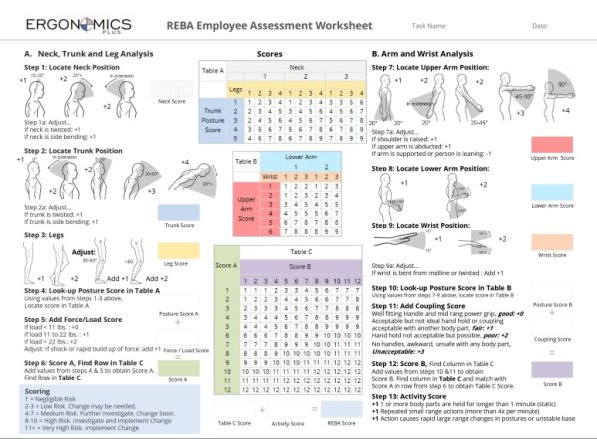Effect of Using Mobile Phones on Posture for Children
Info: 25610 words (102 pages) Dissertation
Published: 17th Dec 2019
Tagged: PhysiologyMobile Phones
CHILDREN’S POSTURAL RISK WHEN USING MOBILE TECHNOLOGY
Industrial & Manufacturing Engineering & Technology
Abstract
Maintaining the musculoskeletal health of children using mobile information and communication technologies (ICT) at home presents a challenge. The physical environment influences postures during ICT use and can contribute to musculoskeletal complaints. Few studies have assessed postures of children using ICT in home environments. The purpose of the study was to conduct the Rapid Entire Body Assessment (REBA). The final scores which include wrists, forearms, elbows, shoulders, neck, trunk, back, legs and knees upper arm score, lower arm score with recommended action levels are determined using videotaped scenarios of children using two types of mobile ICTs and compared to those of the recommended scores and levels.
Keywords: minimizing risk, mobile technologies, Rapid Entire Body Assessment (REBA).
1. Introduction
Information and communication technologies (ICTs) are an indispensable part of modern day society. Several studies report associations between ICT use in children and adolescents and musculoskeletal discomfort (Be´langer , 2011; Hakala, 2006; Jacobs and Baker, 2002; Straker , 2008;) which are similar to those observed among adult computer users in vocational settings (Gerr , 2004). Given that children are still developing physically, there was reasonable concern regarding the long-term impact of such exposure on their musculoskeletal health (Belanger, 2011). Recent technological advances have inspired a genre of portable, compact and personalized ICT devices, such as laptop computers, touchscreen tablets and smartphones. These mobile devices can be used in a wide range of physical environments while adopting a range of postures (Baker, 2012). In other words, anywhere can be considered an ICT workstation. However, Studies into the postures adopted by school-aged children while using an ICT workstation have predominantly been within school environments (Harris. C, 2000).

Figure 1. Participant using the ICT Laying on the floor
Limited research exists on the postural risks associated with children’s ICT use in the home environment. At home, children are likely to use their mobile ICT devices for unsupervised leisure and social pursuits, have longer durations of use for completing educational tasks than when at school, and adopt a range of postures across different locations in the home (Breen.R, 2007).

Figure 2. Participant Using the TAB on the Sofa
2. Background
Posture was an independent risk factor for MSDs among computer users. The most consistent finding was that locating the device at or below the height of the elbow and resting the arms on the desk surface or chair armrests was associated with reduced risk of neck and shoulder MSDs (Gerr, 2004).
Digital gaming is to be related to LBP (Low Back Pain) and NSP (Neck Shoulder Pain). Playing video games has previously been reported to be a risk factor for LBP among 9-year-olds Hakala (2006).
Digital game playing as in computers, the Internet, television, and console games was a multiform activity of different postures. Although mostly requiring repetitive hand motion in sitting position, the basic mechanism of gaming relies on dynamic action where players change postures freely and the loading of the upper extremities was minimized. On the other hand, LBP was known to be related to prolonged sitting when exposure times in digital gaming and computer use were high (Hakala, 2006).
According Baker the use of computer may be associated with musculoskeletal complaints in a population of middle school aged children (2012). The risk factors associated between musculoskeletal discomfort in children and computer use was very similar to those risk factors being cited in the adult literature.
However, there has been much less research on children and computer use, so there has been less impetus to provide ergonomically correct computer workstations for children at home. This paper tries to emphasize on children developing the risk of MSD due to improper posture.
2.1 Musculoskeletal Disorders (MSDs)
MSDs are a common problem for people across the United States. Musculoskeletal disorders are injuries and disorders that affect the human body’s movement or musculoskeletal system (i.e. muscles, tendons, ligaments, etc.). When the children are exposed to MSD risk factors, they begin to fatigue. When fatigue outruns their body’s recovery system, they develop a musculoskeletal imbalance. Over time, as fatigue continues to outrun recovery and the musculoskeletal imbalance persists, a musculoskeletal disorder develops (Grimes. P, 2004).
Pain, headaches, and muscle fatigue can develop in the neck and upper back region after just 20 minutes of computer use. The longer the duration on one task, more discomfort may result. 60% of students have reported discomfort with laptop use, and 61% have reported discomfort carrying their laptop (Grimes. P, 2004).
2.2 Problem Statement
With increasing numbers of children using mobile ICT devices at home, it is important to assess their impact on children’s posture, so that appropriate guidelines for the healthy use of these mobile technologies can be developed.
2.3 Research objective
The objective of this study was to
- Obtain grand scores and action levels on the REBA, while undertaking postural risk assessments of a child using mobile ICT devices in a home environment.
- Identify the better position for children using mobile ICTs in a home environment.
- Provide suggestions on how to translate ergonomics principles for healthy ICT use among children into practical solutions for people to manage postural risks.
- Methodology
3.1 Ergonomic assessment tool (REBA)
This ergonomic assessment tool (REBA) uses a systematic process to evaluate whole body postural MSD and risks associated with job tasks. A single page worksheet is used to evaluate required or selected body posture, forceful exertions, type of movement or action, repetition, and coupling. The REBA was designed for easy use without need for an advanced degree in ergonomics or expensive equipment, just worksheet and a pen.
Using the REBA worksheet, the evaluator can assign a score for each of the following body regions: wrists, forearms, elbows, shoulders, neck, trunk, back, legs and knees. After the data for each region is collected and scored, tables on the form are then used to compile the risk factor variables (Harris.C, 2000).
The REBA rating scale was reported to have good reliability when used by physiotherapists, and industrial and safety engineers to assess adults; although the exact values of the reliability calculation are not documented. Several researchers have used REBA to assess postures among children in school environments (Bao.S, 2007).
The REBA worksheet is divided into two sections labeled A and B. Section A (right side) covers the neck, trunk and legs. Section B (left side) covers the arm and wrists. This segmenting of the worksheet ensures that any awkward or constrained postures of the neck, trunk or legs which might influence the postures of the arms and wrists are included in the assessment.

Cite This Work
To export a reference to this article please select a referencing stye below:
Related Services
View allRelated Content
All TagsContent relating to: "Mobile Phones"
The first commercially available mobile phone was the Motorola DynaTAC 8000x, released in 1983. The high cost mainly restricted the first mobile phones to business until the early 1990’s when mass production brought cost effective consumer handsets. The launch of the first iPhone in 2007 introduced the world to the first phone that closely resembles what we know today.
Related Articles
DMCA / Removal Request
If you are the original writer of this dissertation and no longer wish to have your work published on the UKDiss.com website then please:




